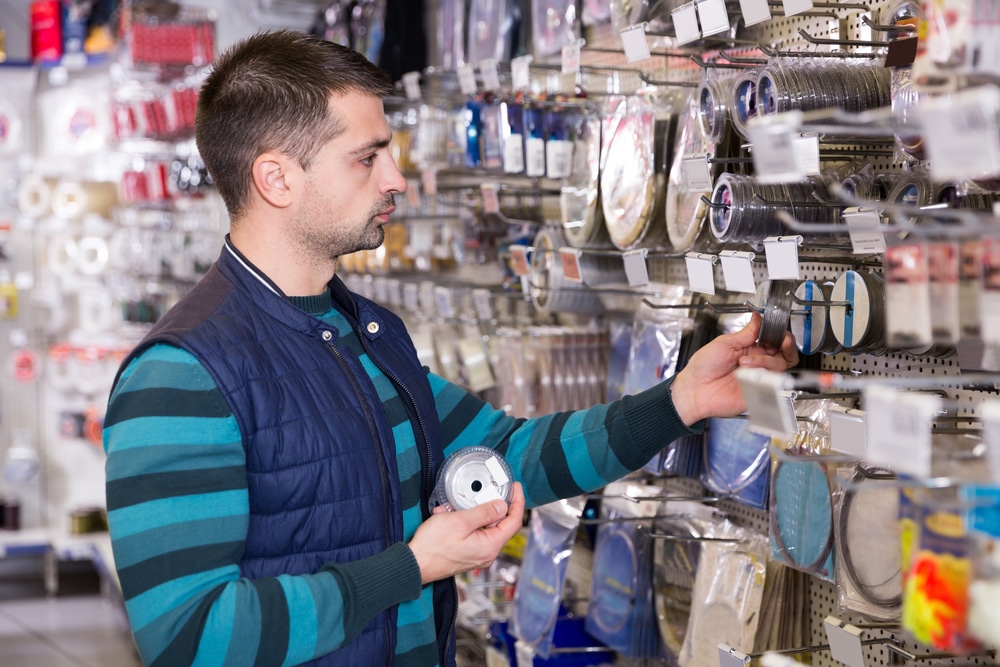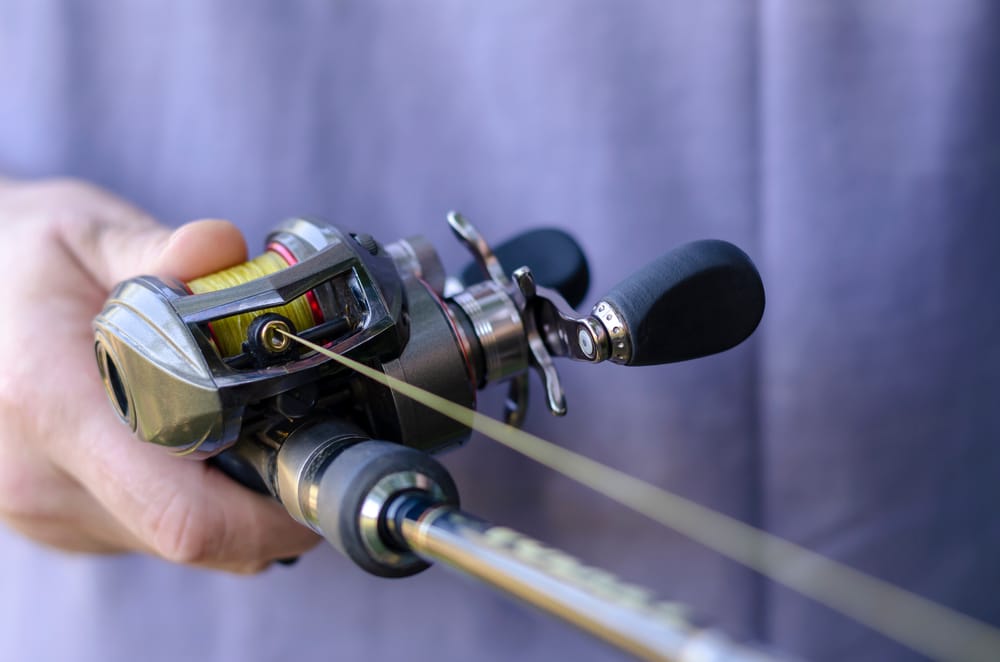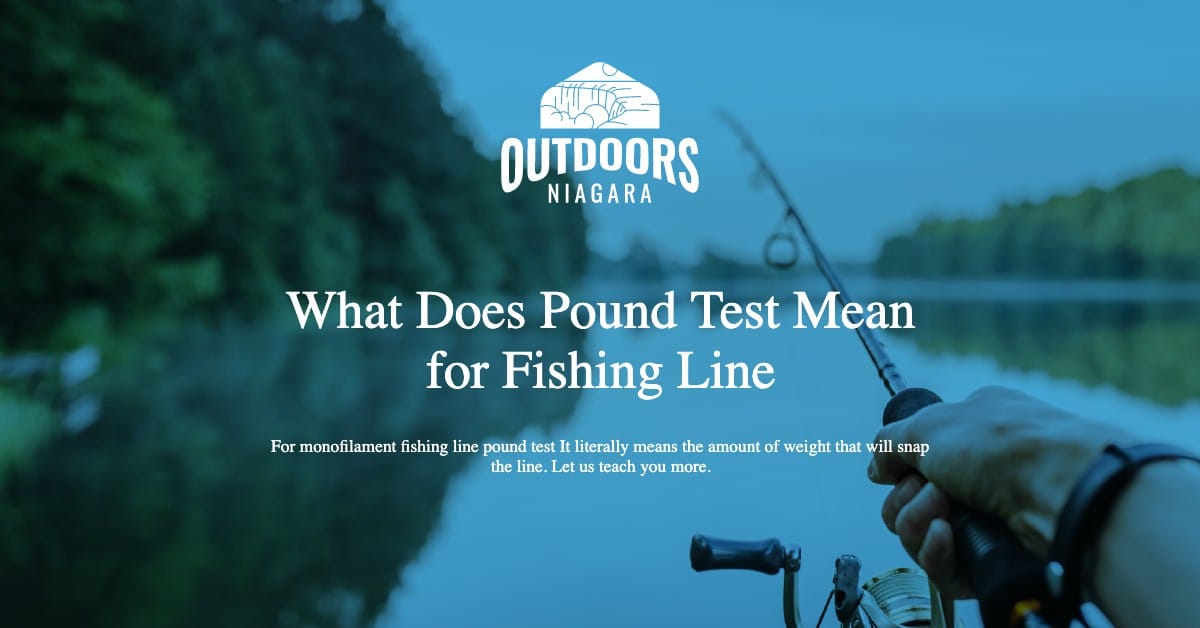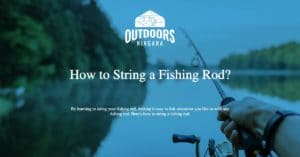When it comes to fishing line, Pound Test means – The amount of weight you can add to the line before it breaks. However, much goes into this definition than is implied.
The angle of the fishing line in conjunction with the power of the rod in conjunction with the action of the rod all come together to form a varying degree of breaking points for fishing line.
For example, if your line is hooked or snagged, and you pull the line in a straight direction with the length of your rod, it will snap much easier than if the line angle is 45° from the rod tip to the water, and you have a large fish on your hook.
For most of this article we will discuss monofilament fishing line.
Unless otherwise mentioned, understand that braided line is much stronger than mono or fluorocarbon.
11-pound mono and fluorocarbon line will be thicker than 11-pound braided line.

Contents
What does Pound Test mean?
It literally means the amount of weight that will snap the line.
If you have a line with ten pound test rating, a ten pound fish may snap the line.
An 11-pound fish has more risk of snapping the line. A 20-pound will most likely snap the line.
The degree of accuracy has to do with the play in your fishing rod and the strength of your leader and some other factors that help absorb the weight of a fish.
Since Pound Test means the amount of weight the line will support before breaking.
It is an indication of the types of fish you can target given the line strength.
It also means the relationship between successful fishing and the capabilities of your equipment.
Line pound test is given for both your fishing rod and your reel.
When you target fish correctly, you are pairing the rod with the reel with the line, with the lure or bait weight.
The fishing rod will tell you the range of line pound test, the lure weight.
The fishing reel will tell you a range of line pound test and for the most port, the drag strength will limit you on what fish you can target.
When you hook a big fish on a lightweight reel it will strip the line out until the reel burns up or the spool runs out of line, and then it will break the line or the pole.
So, pound test on fishing line is a component in the equation we use to figure out how to pair our gear with the population of fish that we want to and can target.

What pound test line should I use for fishing?
The average freshwater angler uses a line pound test ranging from 4-12 pounds.
That range will cover a mix of fish – mostly smaller – cutthroat trout, smallmouth bass, brook trout, bluegill, perch, crappie, arctic grayling.
However, if you want to catch bigger fish in freshwater lake you will need to up the pound test to 10-15 pounds.
A 15 pound test line will be strong enough to handle bigger trout – big, fat, brown trout, 30″ rainbow trout you find in Alaska, Big, fat Lake Trout.
For saltwater fishing
For Saltwater the pound test average ranges from 12-15 pound for surf fishing and inshore targets.
You may go much heavier for bigger fish 50+ pound test. A big Marlin will snap most line, so anglers go for mono in the 100 pound test range.
12-15 pound test will handle smaller saltwater fish – perch, bone fish, small reds, spotted trout, sea trout, etc.
For larger fish you will bump the line rating to 20-30 pound test.
The heavier line will handle cobia, tuna (30-40 pound test.)
For trophy fish, such as shark, you bump up the line rating to 100 pounds or more.
What is 4lb fishing line used for?
We mentioned that the average freshwater fishing line in pound test is from 4-12 pounds.
Do people really use 4 lb test line? Four-pound test line is an okay choice for sun fish, bluegill, crappie, bait fish such as herring and shads.
In fact, if you are jigging for bait fish a 4lb line is a good option.
A very common pound test for smaller poles is 6lb test.
How strong is 6lb test line?
Six pound test line is strong enough to handle small fish such as brook trout, bait fish, pan fish, bluegill, perch, and sun fish.
It is a good line to use to target fish that stay under five-six pounds.
A 10-12 pound test line would be your next choice for general fishing where you might tempt a fat largemouth bass to strike.
What can you catch on Different Pound Test line?
10-pound test line means that it takes ten pounds of weight to break the line. It also means you can catch a variety of freshwater fish.
Ten pound test makes a good line for small trout species such as brook trout.
It also will handle smaller brown trout and rainbows, smallmouth bass, and some small largemouth bass.
12lb Test Line
You might wonder what does 12lb fishing line mean?
It means you can catch a 12-pound fish with little fear of the line breaking due to the fish’s weight.
It also means you can target any fish that are smaller than 12-pounds.
A 12-pound test fishing line is a good all around choice for larger freshwater fish and smaller saltwater fish.
Fish bigger trout – rainbows, browns, and lake trout. Fish smaller saltwater fish such as perch.
30lb Test Line
What about 30lb fishing line? What is 30lb fishing line good for? Thirty-pound test fishing line is good for many small and medium-sized saltwater applications.
You can fish big red bulls, speckled trout, bonefish, smaller cobia.
So, what about braided line? What size fish can 30lb braid catch?
The record for 30-pound braid is a fish that is 49 pounds, and it was a stripped bass.
I would not trust 30-pound test line for fish over 50 pounds, but part of the fishing adventure is being able to tell people that you landed a 60-pound shark on 30-pound braid. There’s risk in adventure.
If you are talking about 30-pound braided line, then you can target small sharks, tuna, big cobia, and other game fish.
Bigger Saltwater Fish
50-100lb test line is what you need for bigger saltwater fish.
A big tuna or marlin may require line stronger than 100 pound test.
FAQ About Pound Test for Fishing Line
What Is the Strongest Fishing Line?
For Mono – 330 pound test line is about a strong as it gets. For braided line, you can hit the 550 pound test limit.
The all tackle world record for Pacific Halibut is an amazing 459 pounds.
Unless you are fishing from the shore in Alaska, where big fish can lurk near shore, a starter line for surf fishing is 20 lb braid.
If you plan only to target smaller to medium-size fish, such as perch, snapper, reds, speckled trout, bone fish and snook, then 20 pound braid is good.
If you think you might hook a big Ling Cod, Cobia, or Shark, then up the pound test to 50-60 pound braid.
All three of these predatory fish will hunt for smaller fish in the surf.
What Color Fishing Line Is Best?
Generally, green line is the best, but not always. In clear water you want to go with clear line.
In stained water or where there is some turbidity, go with green.
If you need a high visibility line orange or blue can be a good choice.
Fishing for big catfish is an instance where high visibility line is key.
You will need to watch the line movement rather than feel for a bite from a catfish.
What Happens if You Put Too Heavy Line on A Reel?
You will not be able to fit as much line on the spool.
Another negative of adding line that is too heavy is that you lose the advantage of casting lures that are designed for your pole.
If you plan to target big fish by adding heavier line to your reel, you may break the reel or the pole.
What Fishing Line Is Better Mono or Fluorocarbon
Neither is better, but they have better uses given the fishing. Monofilament can take a lot of abuse.
It has some give to it and will handle big fish.
Fluorocarbon fishing line is a little stiffer, but it also can mar more easily.
Fluorocarbon is a little harder to see in the water-tinted water than mono is.
Is Braided Line Better than Mono?
Braided line is the go-to line choice for most anglers these days.
Is it better than mono? Maybe. It is definitely stronger given the diameter.
If you need to add more line to your spool, reaching for the same pound test braided line will allow you to put more braided line on your spool over mono.
Braided line is strong and thinner in diameter than mono or fluorocarbon lines.
For most fishing applications, reach for braided line.
It offers a thinner diameter than mono or fluorocarbon for the same pound test, and it wears better than both.







